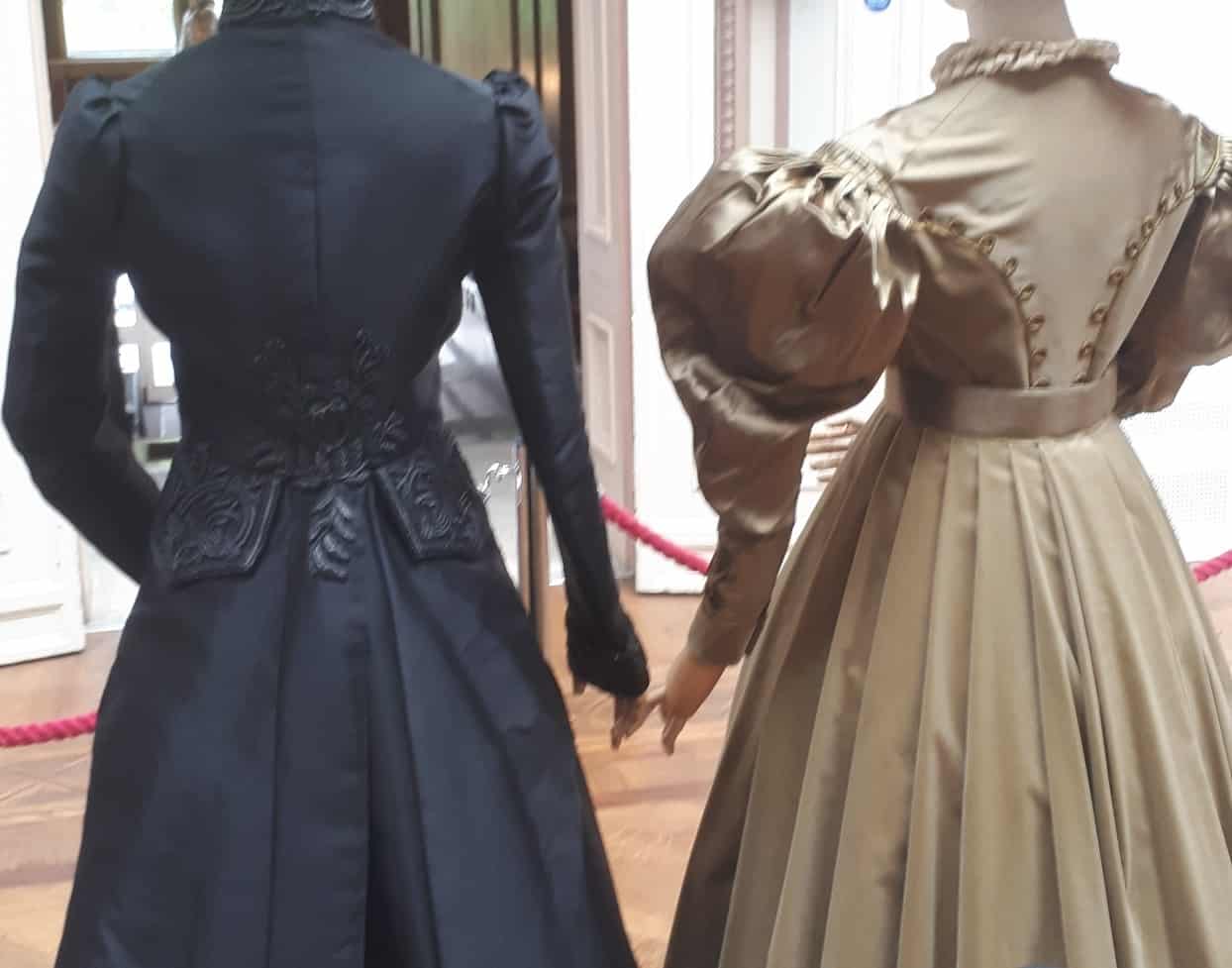Imagine a dramatic long black coat, a confident top hat and a challenging walking cane for the Gentleman Jack fashion silhouette shorthand of Anne Lister of Shibden Hall, Halifax, England.
Contents
Bankfield Gentleman Jack Fashion Exhibition
Elinor Camille-Wood Curator and Collections Manager of Bankfield Museum in Halifax, near Shibden Hall, Anne Lister’s historic home, hosts a collection of over 30 iconic Gentleman Jack Fashion costumes. Bankfield has a range of galleries and displays including, art, local history including Gentleman Jack, Anne Lister, and her wife Ann Walker – and the Duke of Wellington’s Regimental Museum.
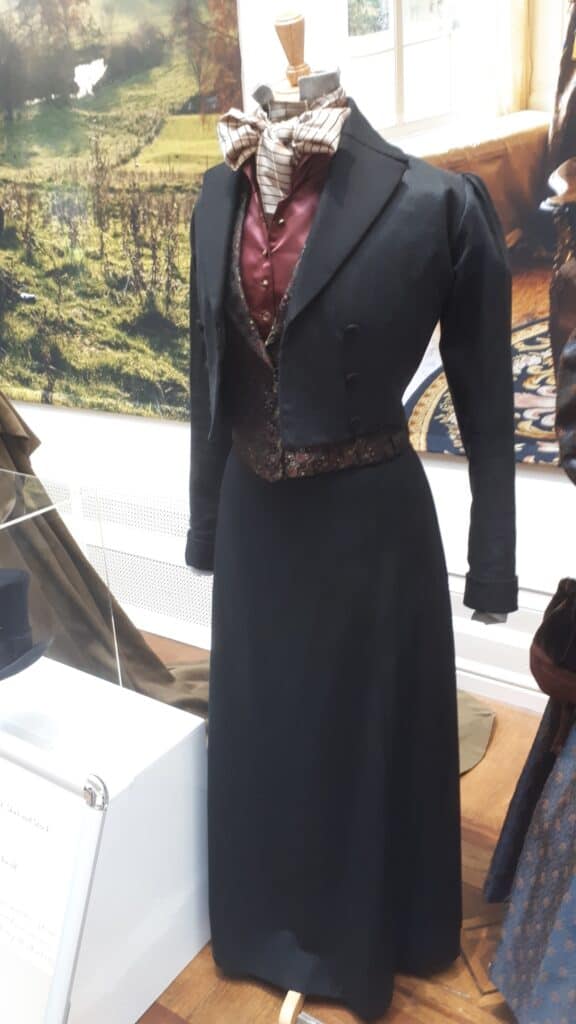
Gentleman Jack Designer Tom Pye Creator of the Gentleman Jack Look
For the Gentleman Jack look, acclaimed costume designer Tom Pye chose a masculine top half and a plainer bottom half theme to emphasize the top.
There are many contemporary mentions of how Anne Lister walked about the place, so costume designer Tom Pye for Gentleman Jack, wanted coats that look great, that swish around with movement, a silhouette that’s really strong and looks like a man from a distance.
For Anne Lister’s Gentleman Jack look, designer Tom Pye wanted her to look cool and he wanted gay women to have an icon, as it is so rare we see that kind of character on TV.
Designer Tom Pye also gives credit to actress Suranne Jones, a joy to dress and tailor. Suranne Jones wears costumes so well and he loves having fittings with her as she has opinions, is collaborative and is easy to work with. All her fittings involve her striding up and down the corridor to see how things move.
How did Tom Pye Design for Gentleman Jack?
For season one of Gentleman Jack Tom Pye has stated that he used bold brush strokes to allow the audience to easily identify characters and work out their status. For Anne Lister’s Gentleman Jack look, Tom Pye used the male top hat, (popular with men of the era) masculine top half and a plainer bottom half theme to emphasize the top. It worked to give what has become the immediately recognisable iconic Gentleman Jack look.
For season two of Gentleman Jack, designer Tom Pye felt he could introduce much more nuance and subtlety. He enjoyed playing with the characters’ changing roles, for example when Anne Walker moved in with Anne Lister at Shibden Hall.
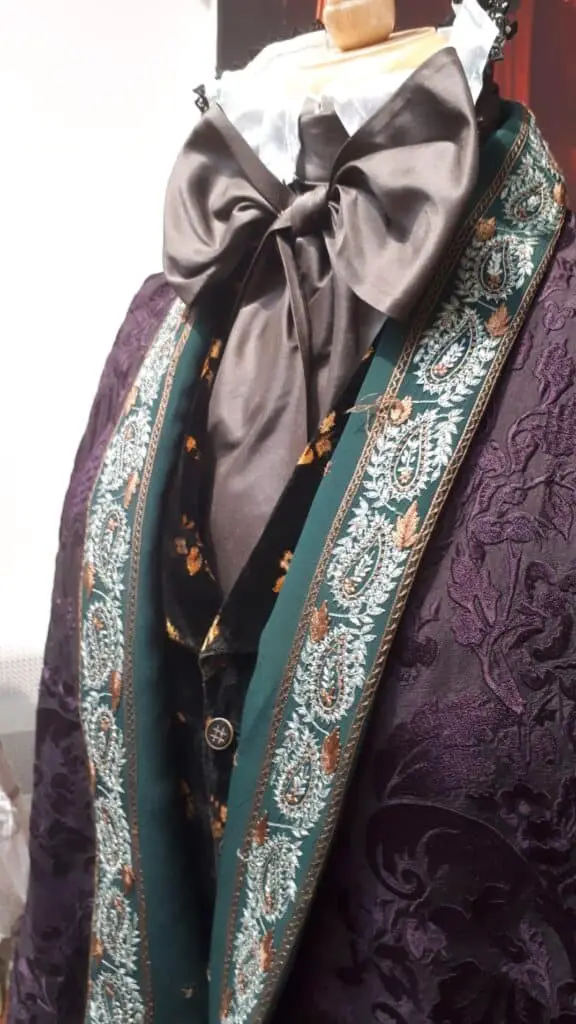
In season two of Gentleman Jack, Anne Lister also gets better clothes as Tom Pye imagined that having a person like Ann walker moving into Shibden Hall would have an effect on everyone living there.
In season one of Gentleman Jack, Tom Pye describes Anne Walker as very pink and fluffy, and pale blue, and quite clearly very feminine and girly.
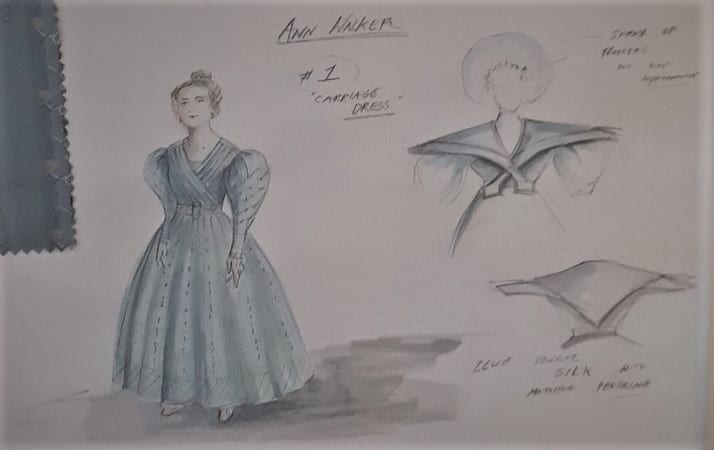
Tom Pye Sketch: Ann Walker dress with Pelerine Worn by Actress Sophie Rundle. Designed by Tom Pye. Made by Amanda Grange
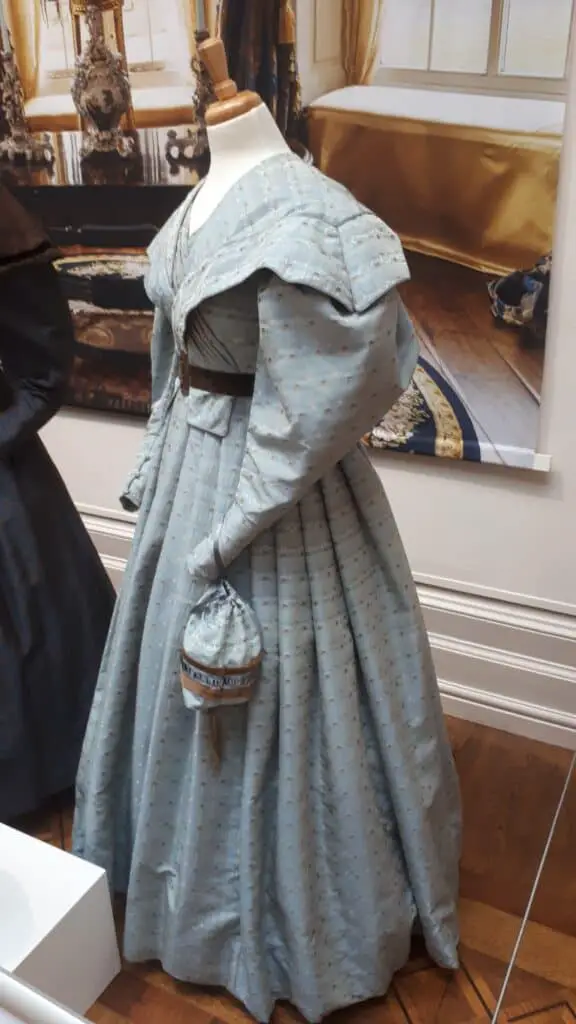
This dress was worn in both series 1 and 2 of Gentleman Jack by Ann Walker. In episode 1 series 1 when she was involved in a carriage accident and then worn throughout the series whenever she is travelling, most notably in episode 8 Series 1, where Anne and Ann were reunited. The material was supplied by Fucotex, Germany.
In season two he gave Ann Walker eucalyptus colours and darker pinks.
How did Tom Pye Make the Costumes for Gentleman Jack?
Tom Pye and his team make the costumes, in the same way that they would have been in the 1830s – the structure and construction of what is underneath the dresses is exactly the same. For instance, they have little feather pillows tied on the corset straps at the top of the arms to support the big sleeves.
Designer Tom Pye also enjoyed making the looks for Anne Lister and Ann Walker going mountaineering, using the descriptions in Anne Lister’s diary of her lifting her skirts up.
Why does Gentleman Jack Wear a Top Hat?
To complete the Gentleman Jack look with coats that look great, that swish around with movement, a silhouette that’s really strong and looks like a man from a distance Tom Pye decided to complete it with the now-iconic Top Hat.
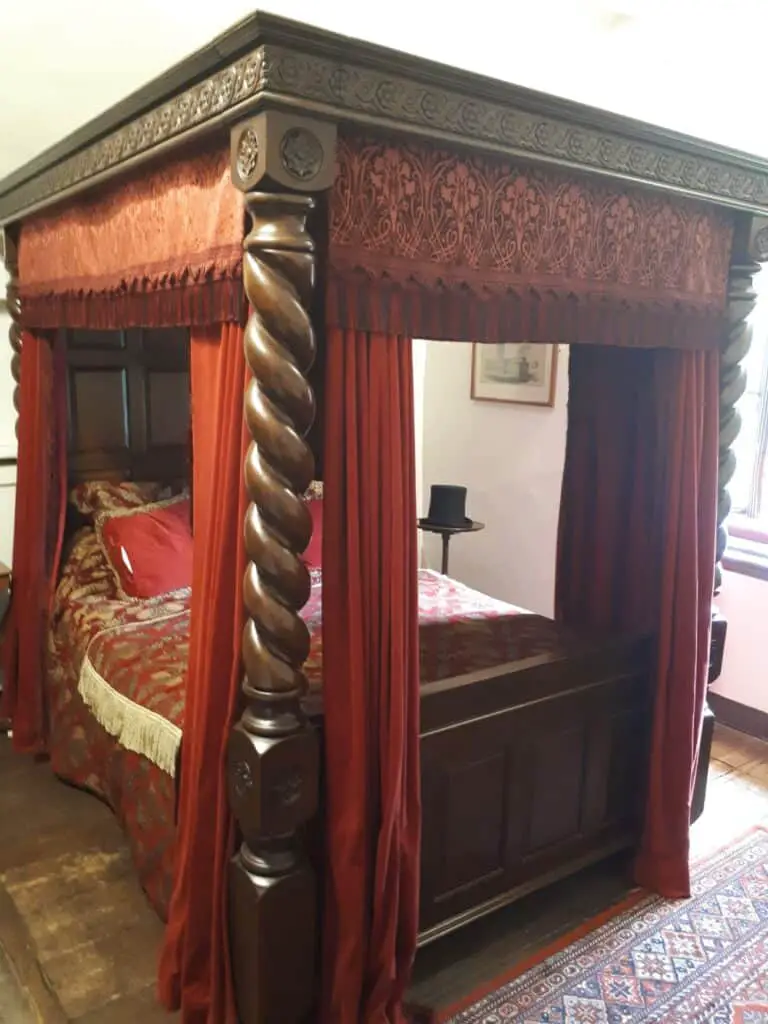
Gentleman Jack’s Iconic Top Hat in Anne Lister’s Bedroom at Shibden Hall
Tom Pye was looking at other lesbians of the Anne Lister period, such as the Ladies of Llangollen, and he was also researching George Sand. (George Sand was the nom de plume of period writer Madame Sand who appeared at readings dressed in men’s clothes).
The Ladies of Llangollen and George Sand wore top hats and Tom Pye used those contemporary styling cues as it was not too much of a stretch. There’s no mention of Anne Lister wearing a top hat in the diary, but it really worked on Suranne Jones, the actor playing Anne Lister.
Gentleman’s Jack’s top hat was the only place Tom Pye says he did not follow Anne Lister’s diaries. Tom Pye knew from Anne Lister’s diary that she wore a small velvet black cap, probably an early Regency shape, but that just didn’t excite him. The other thing Tom Pye was worried about was Anne Lister looking a bit normal to a contemporary audience. Just wearing black and men’s clothes isn’t that surprising to 21st-century viewers.
Who Designed and Made the Hats for the Gentleman Jack series?
All the hats were designed by Tom Pye and made by milliner Sean Barrett who also made hats for The Crown and Downton Abbey.
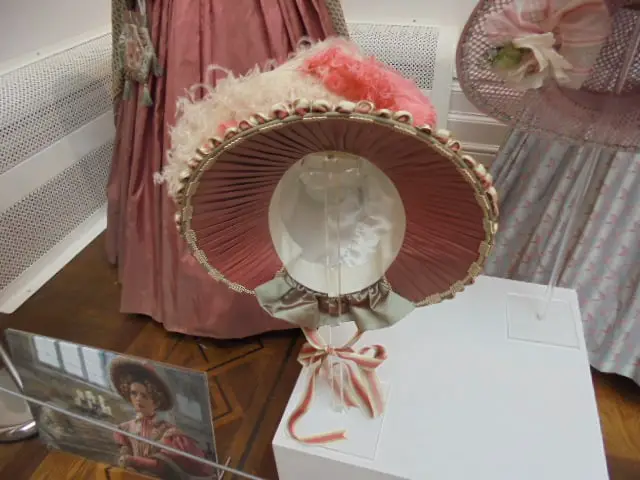
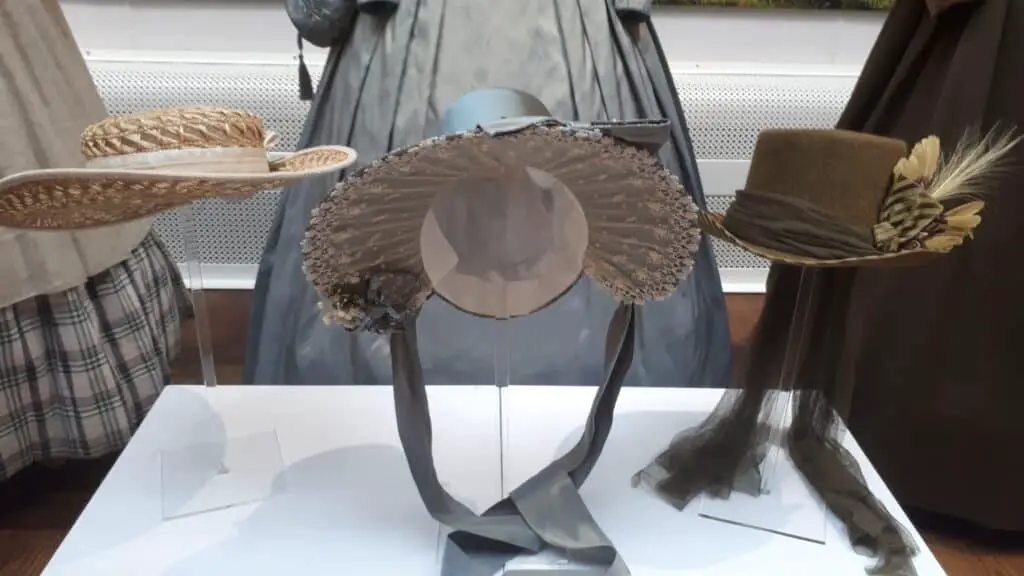
Gentleman Jack’s Hair Style
Tom Pye worked with hair and makeup artists Lynn Davey and Sue Newbould. There are portraits of Anne, plus Tom Pye had his sketches. Anne Lister had both vertical curls and in some, horizontal. It came down to practicality about wearing a top hat and what would work with the hat – looking at the curls they decided to go with the horizontal look.
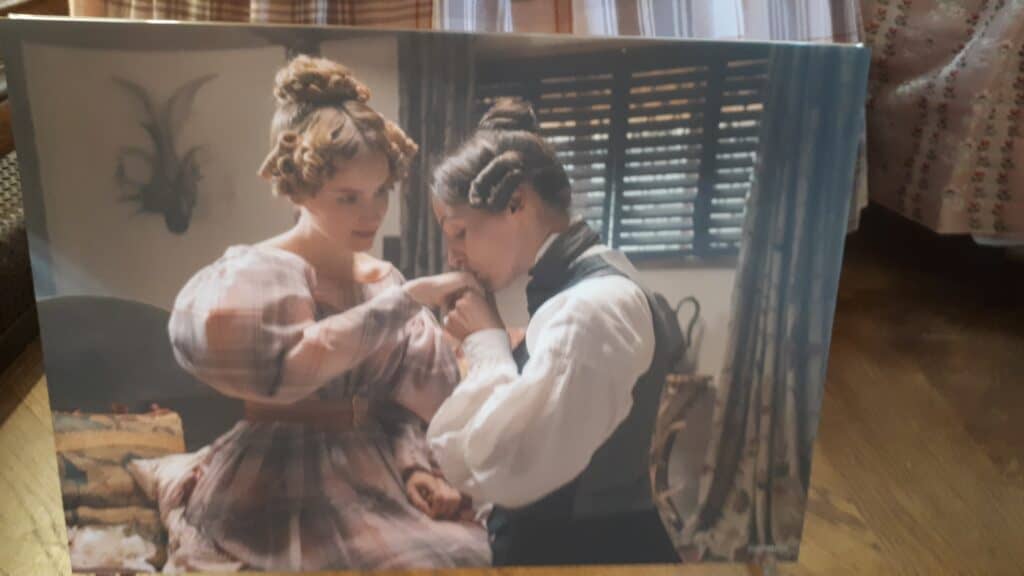
Gentleman Jack’s Eyebrows
Actress Suranne Jones stopped plucking her eyebrows and allowed nature to take its course for series two of Gentleman Jack – they are a lot thicker than they appeared in series one.
Fashion in Anne Lister’s Lifetime
Anne Lister lived from 1791 to 1840 and fashion evolved and changed for both women and men.
Prior to Anne Lister’s birth in 1791, fashion had been based around extravagance and opulence with brocaded gowns and wide dresses supported by paniers. For men it was embroidered coats. Both sexes wore elaborate powdered wigs.
By the end of the 1700s dress for both men and women returned to a more simple shape.
By reading the following information, you’ll appreciate the styling cues, so skilfully used by Tom Pye in the production of Gentleman Jack.
For women, panniers, bustles and heavy fabrics gave way to high waisted white muslin cambric or calico gowns inspired by the neoclassical styles of ancient Greece which became known as Empire Gowns.
Empire gowns, sometimes transparent, were worn floor length with heelless slipper shoes.
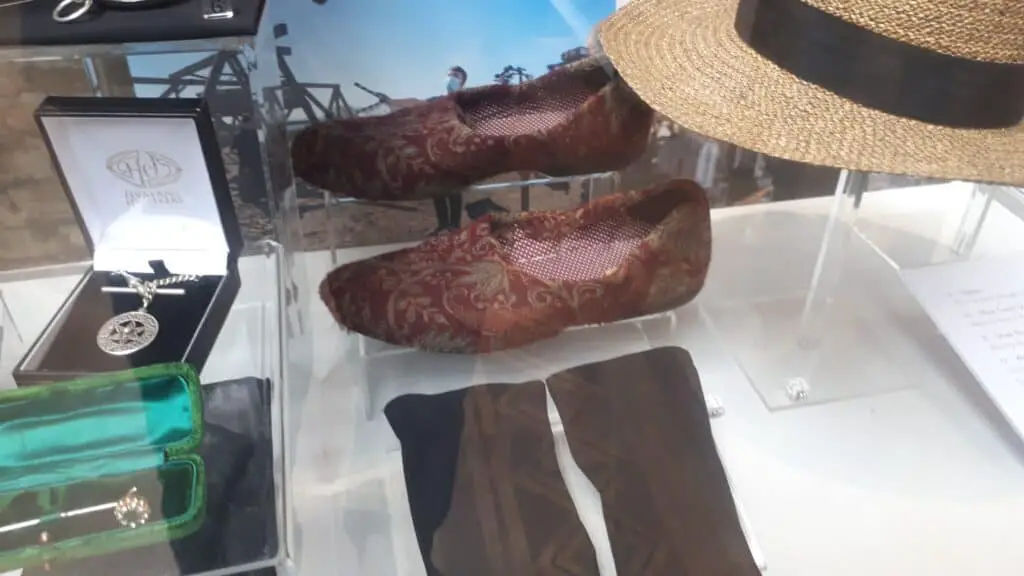
The simple design of Empire Gowns had no pockets, so reticule, a small handbag became a necessary and fashionable accessory in those times.
Shawls with intricate designs and bold colours were also an essential part of a woman’s wardrobe in the British Isles. Shawls provided much-needed warmth and it was considered the mark of a genteel lady to be able to wear a shawl in an elegant manner.
Anne Lister was 21 on April 3rd, 1812. In the period the 1810s-1820s, women’s waistlines remained under the bust but the gowns began to take on more structure with puffed and slashed sleeves becoming popular and skirts becoming an a-line shape with decoration added to the hems.
Over the dress, a spencer would be worn. This short jacket would provide a contrast to the muslin dress beneath and be made of thicker fabric such as silk or wool and often worn with a matching hat or jacket.
Pelisses were in fashion during the first forty years of the nineteenth century. In the early years, it followed the high-waisted line and had a belt and was ankle-length with long sleeves.
However, with the wider skirts of the 1830s, there was a return to the pelisse in the mantle style, which hung loose to three-quarter length and had a waist-long cape which formed hanging open sleeves.
Men’s clothing in this period 1810s-1820s continued to consist of a dark tailcoat jacket, contrasting waistcoat, with lighter coloured trousers fitted into riding boots.
Men’s collars were worn high with a cravat, tied in a knot or bow – top hats were the choice for both daytime and evening wear.
Men would carry a cane and be clean-shaven with short hair that was sometimes intentionally dishevelled.
Menswear in the 1830s reflected many of the same influences in womenswear. Men wore flared coats nipped in at the waist and sleeves that had a puffed shoulder, echoing the gigot sleeves of female fashions.
Men wore white shirts with high, straight collars with either a stock or a cravat. A stock was a stiffened band worn around the neck, fastened at the back end and covered with silk, satin or velvet. A cravat was a large piece of cloth tied around the kneck that could be arranged in several ways and often held in place with a long decorative pin.
One of the most colourful and elaborate elements of a man’s wardrobe was the waistcoat which was made in a variety of patterns and fabrics often with a rolled or shawl collar. it was also fashionable to wear more than one waistcoat at a time, in layers.
For men’s headwear, the top hat was the standard choice for both day and eveningwear.
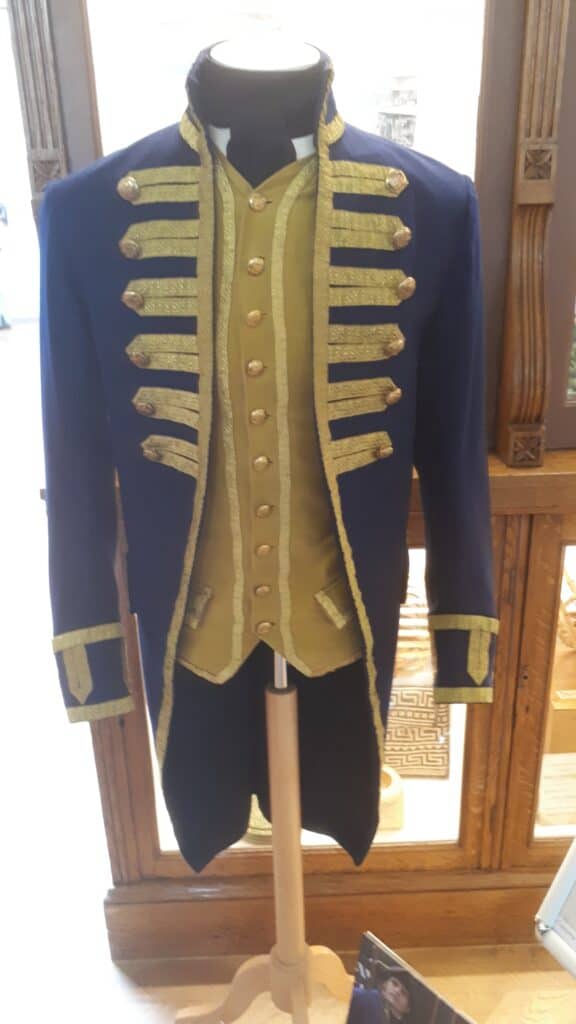
The Livery Set and Overcoat were worn by Ben Hunter in Gentleman Jack. It was designed by Tom Pye. The Livery set was made by Fiona Bunting and the Overcoat was made by Hester Peden.
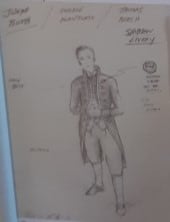
It was worn throughout series 1 and 2 of Gentleman Jack. The Shibden Hall Livery was designed in a mustard yellow to coordinate with the Lister Coat of Arms and the Lister Carriage. The Coat of Arms was embossed onto the buttons which were then 3D printed.
The Lister Chase Carriage as used by Anne Lister and Ann Walker can be viewed in the Aisled Barn at Shibden Hall.
Did women change clothing often in the Gentleman Jack era?
The daily life of upper class 1830s women would involve changing their outfits many times during the day.
Depending on the daytime activity a lady might choose to change into a carriage dress, promenade dress or horse-riding habit.
If a lady were to go out for a stroll in the morning she would change into a walking dress. A popular style in the 1820s was a Petisse Robe – a type of dress in the style of a coat that fastened down at the front with long sleeves, a high waist and collar. A Petisse Robe could be made of cotton or wool and was often trimmed with fur.
As the day progressed, an afternoon dress would be worn to afternoon events such as taking tea, garden parties or afternoon weddings.
An afternoon dress was more elaborate and decorative than a morning dress and resemble an evening dress in its design with a wider open neckline and made from luxurious materials such as silk.
Later, an evening dress would be worn to dinner. This was the most elaborate dress worn of the day. It would have a wide-open neckline cut low on the shoulders with shortened puffed sleeves, a tight waist and an ankle-length skirt with trimmings beginning at the level of the knee. hair would be decorated with ornaments and beads and flat, silk slippers would be worn.
What is a Spencer?
The clothing item spencer, dating from the 1790s, was originally a mens’ woollen outer tail-coat but with the tails deleted.
Spencers were worn as short waist-length, double-breasted, mens’ jackets. Spencers were originally named after George Spencer, 2nd Earl Spencer (1758–1834), who is reported to have had a tail-coat adapted after its tails were burned by coals from a fire. The style was adopted as mess dress by British military officers.
It was also soon adopted as a popular women’s fashion on both sides of the Atlantic during the 1790–1820 Regency style period. The spencer was worn as a cardigan, or as a short fitted jacket cut to just above waist level, or to the bust line and tailored on identical lines to the dress.
The use of the term spencer continued well into the 19th century to mean more generally any type of short jacket or coat.
Clothing Fabric Patterns in the Gentleman Jack / Anne Lister / Ann Walker Era
Roller printing on textiles had been introduced in the late 1700s and at first, it was used mainly for small patterned dress fabrics. Improvements in technology resulted in more elaborate roller prints in bright, rich colours such as ‘Turkey Red’ and ‘Chrome Yellow’ from the 1820s.
Through the 1820s and 1830s, popular patterns included designs based on nature with spots and stripes. Precise printing eliminated the need for dark outlines on printed designs and new green dye appeared in patterns of grasses, ferns and unusual florals.
A cotton patterned day dress designed by Tom Pye and cut and made by Sarah Hartley was worn by Gemma Whelan as Marian Lister throughout series two of Gentleman Jack. The dress has typical 1830s sleeves and piping detailing across the bodice.

Marian Lister’s cotton patterned day dress from Gentleman Jack.
Marian was Anne Lister’s Sister who looked after the estate whilst Anne Lister and Anne Walker were away travelling in the 1830s.
Pattern copying became such a problem that eventually a law was passed whereby manufacturers could register their designs for protection and recompense – the Ornamental Design Act of 1842 – two years after Anne Lister’s death on her travels, but well before Ann Walker’s death in 1854, aged 50.
13 Anne Lister Diary Quotes on Clothes, Dressing and Fashion:
- Anne Lister Diary, Friday 16th August 1816:There was a ball in the evening but we did not think it worth the trouble of going – the fuss of dressing at 9 to break up, according to the rule precisely as the clock strikes 11.
- Anne Lister Diary, Wednesday 2nd April 1817: Began this morning to sit before breakfast in my drawers and put on with the gentleman braces I bought for 2 shillings and six pence Monday March 1809, Poor Sams old black waistcoat and my dressing gown.
- Anne Lister Diary, Saturday 20th December 1817: Walked to Gradon’s, the shoemakers at Haley Hill, to order a pair of strong shoes – and reached Shibden a little before 9.
- Anne Lister Diary, Sunday 1st June 1817: A fine day, the pleasantest we have had this year – and the first I have thrown aside my winter things having changed my black cloth spencer and black straw hat for a black silk spencer and common straw hat – I have almost made my mind up to always wear black.
- Anne Lister Diary, Tuesday 21st October 1817: Directly after dinner walked to Halifax – went to the library – paid Mrs Farrar, the dressmaker, a bill of my mother’s – 7/7½ dated 23 April 1815.
- Anne Lister Diary, May 1819: The people stared at my little round hat – Black hip trimmed with crape and black cloth pellise.
- Anne Lister Diary, March 1823: Walked home with Miss Pickford…I wish she would care a little more about dress. At least not wear such an old-fashioned, short-waisted, fright of a brown habit with yellow metal buttons as she had on this morning.
- Anne Lister Diary, Thursday 17th July 1823: Called at Shepherd’s, the breech makers in Southgate and ordered a pair of leather kneecaps to keep my knees warm when I am reading and save me the trouble of having the plaid to lay over them.
- Anne Lister Diary, Monday 15th September 1823: This morning I wore my velvet spencer and net frill over my cravat. I must manage my appearance and figure differently. Must get a silk pelisse, perhaps from Miss Harvey.
- Anne Lister Diary, Friday 27th August 1824: Strolled along the Burlington arcade and had my hair cut by the said-to-be -best in London, Truefitt, New Bond Street. I think Parsons of York does it quite well. No more ringlets, and corkscrew curls – large curls, not too low on the face. Long waists certainly. The walking about people wear from few to many flounces. (Anne Lister was known to have owned and worn fake curls).
- Anne Lister Diary, Sunday 15 April 1832: Tis striking 6 – dressed – dinner a 6¾
- Anne Lister Diary, Monday 3rd September 1832: Changed my dress in ten minutes and went down into the walk…Put on my new pelisse. First time, and off with Miss Walker, who had been sitting ¼ hour with my aunt at 11.50.
- Anne Lister Diary, Tuesday 3rd December 1833: After your abuse of my travelling cap, I did not put it on the first night, but I soon found that beauty can not long stand against utility.
Gentleman Jack and Halifax
A free to enter display, held at Bankfield Museum in Halifax with over 30 iconic costumes created by designer Tom Pye, the Costume Designer of Gentleman Jack, from Tuesday 31 May to Saturday 24 December 2022.
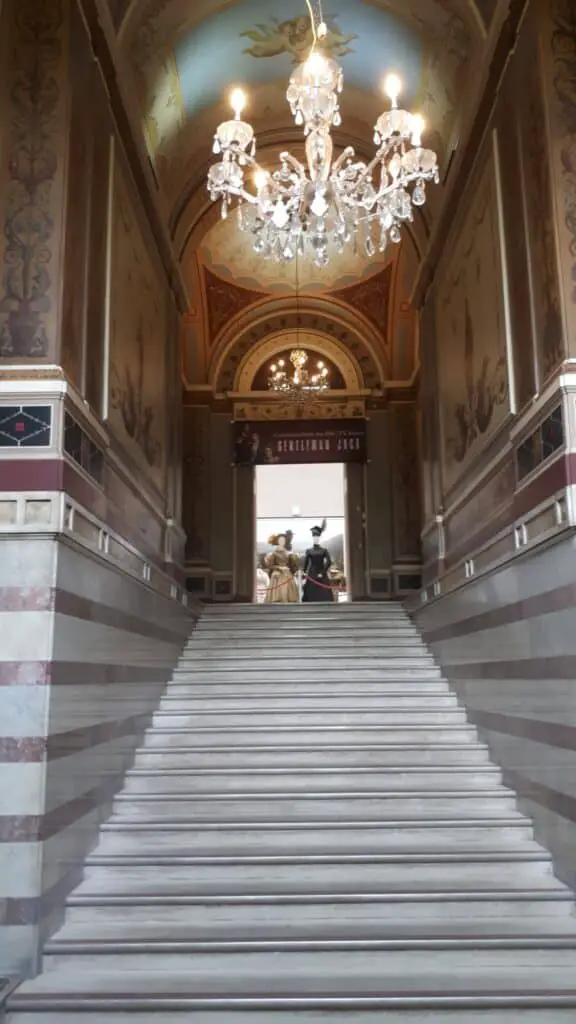
Bankfield Museum is close by to Shibden Hall the home of Anne Lister.
The meaning of Gentleman Jack
Gentleman Jack Series creator Sally Wainwright states the meaning of Gentleman Jack was a vulgar term in Yorkshire at that time. In the title Gentleman Jack – Jack meant lesbian.
The title Gentleman Jack was a name Anne Lister was given by her neighbours, who ridiculed her appearance and sexual preferences. Dating women and wearing masculine type clothing were things that society thought only a man should do – so her contemporaries began referring to her as Gentleman Jack as a slur. Lesbian wasn’t a word back then and there was no community.
Anne Lister’s long term lover, Mariana Lawton, called her Fred as discovered in Anne’s diary.
Halifax is in Calderdale, Yorkshire, England. There are many attractions in Halifax in addition to Bankfield Museum including, Shibden Hall, Shibden Park, Halifax Minster, Eureka Children’s Interactive Museum and The Piece Hall plus some wonderful bars.
Where to Stay or Eat and Drink in Shibden with Anne Lister Connections
Whether you are just looking for a quick drink or coffee, a leisurely lunch or quality dinner, or want to stay over in a boutique room or the Anne Lister suite, take a look at our article on the Shibden Mill Inn here. The Shibden Mill Inn has been in the ownership of both the Lister family and the Walker family and is less than a 3-mile journey by car or taxi.

